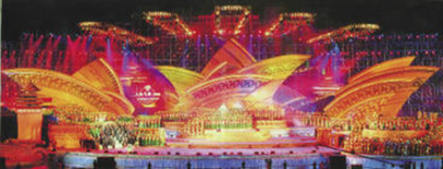Nanning: Comfort with Power
Home of Folk Songs
Naning has a high profile in folk music. The Zhuang people are born singers who can burst into song as readily as they speak. This tradition has a long history, as historic records from the Tang Dynasty revealed that the Yue (ancient Zhuang) people "love songs" and "excel in singing." The third day of the third month on the lunar calendar features the traditional singing festival of the Zhuang people, when entire communities will turn out to sing and dance.
In 1993 the Guangxi regional government began to sponsor an annual songfest on the Double Third Festival, employing that opportunity to invite new friends and investors. In 1999, based on local experience and on researching similar events in foreign countries, the regional government promoted the Guangxi International Songfest to the Nanning International Folk Song Art Festival and entrusted its organization to the Nanning municipal government.
Nanning has not missed the chance to enhance its reputation and exert its influence in the country and around the world, which, it believes, can be achieved through presenting this type of high-standard folk culture festival. Each year, it manages to transcend its own standards; with each festival topping the last. Many local folk songs and autochthonous vocal renditions have earned nationwide and even international fame via this stage. In 2006, several of the singing groups were asked to perform at the Sino-Austrian Salzburg Night, co-sponsored by the Nanning songfest organization committee, China Central Television and Austrian State Television.
|
 |
|
The Opening ceremony of hte Nanning International Folk Song Art Festival. |
The songfest has introduced Nanning and Zhuang folklore to the world and helps draw an increasing number of tourists and investors along with accelerated municipal development. Even locals are surprised at the speed of the changes that have taken place around them over the past decade: Nanning has quickly grown from a small-undistinguished frontier city to a bustling international metropolis with a congenial living environment, enticing many foreigners to fall in love with its treasures and even choosing to settle down.
A Regional Bonanza of Wealth
Nanning is a 1,000-year-old city, serving for many centuries as a major commercial hub for the greater part of Southwest China, which covers southwestern Guangxi and provinces of Yunnan, Guizhou and Sichuan. In 1907, the Manchurian imperial government opened Nanning to foreign trade.
In this new millennium, the city has had a resurgence of development. In October 2003, Premier Wen Jiabao initiated the China-ASEAN Expo at the Seventh China-ASEAN Summit, and Nanning, luckily, was chosen its permanent host, serving as a major channel for China-ASEAN exchanges and cooperation. The expo has five successful runs since 2004, with the sixth due in this October. In the first year alone of the expo, China-ASEAN bilateral trade made a historic breakthrough, achieving a US $105.9 billion mark. In 2007, it doubled to US $ 202.6 billion. And by the end of 2008, bilateral investments had approached US $ 60 billion. There is greater expectation for the upcoming sixth China-ASEAN Expo.
Encouraged by the success of the Nanning expo, the regional and municipal governments conceived of a more ambitious China-ASEAN cooperation plan and proposed it at the First Beibu Gulf-Rim Economic Cooperation Forum in 2006. It is an integrated regional cooperation plan that incorporates the Pan-Beibu Gulf and Greater Mekong River Sub-regional economic zones and the Nanning-Singapore Economic Corridor. The Pan-Beibu Gulf Zone is considered the pivot of the entire project.
In 2008 the State Council approved the Beibu Gulf economic zone development plan and defined the role of Nanning as an "international metropolis that serves China's cooperation with the ASEAN countries." Nanning has since plunged into second drive to build itself into a logistic, trade, financial, transportation, manufacturing and information center in the region. Before long, an economic powerhouse that sustains China-ASEAN cooperation will rise on this fertile territory in Southwest China.
Services
Economy
- Eco-agriculture and Eco-tourism Power Nanchang’s Green Development
- Balance Environmental Protection and Economic Prosperity – Nanchang Looks to European Technology for Green Development
- Sustainable Growth Requires Wiser Energy Use
- Chinese Economy: On the Path of Scientific Development
- China's Economy over the Last Ten Years

